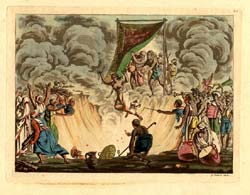To Cry or Not to Cry: Mourning and Burial Customs
To Cry or Not to Cry: Mourning and Burial Customs
Different cultures have exotic ways of mourning and dealing with corpses; some corpses are buried; some are cremated; and some are even removed a skull; some relatives of the deceased mourn in a certain period of time; some mourn then celebrate; some tear their ear lobes; some hire mourners; and some even burn themselves alive.
In Tumleo, Papua New Guinea, the dead is placed in the wooden coffin. The body is covered with clay, adorn with ornaments which will be removed before the coffin is shut. Properties like bones or arrows are to be buried with the corpse. The female relative of the dead would have to do the mourning. The widow will cover her with clay, seclude her from a few weeks to 3 months and sometimes chants a dirge in melancholy tone. The seclusion lasts so long that the ghost arrives to his other world (Frazer,1911). In present, when inheritance of the dead are legalized, seclusion derived a legal implication: to avoid confusion if the widow were to be pregnant afterwards.
The Maori in New Zealand placed much importance on seeing the patience, to wish for their recovery. However, if the patience dies, the Maori believed that the spirit of the deceased would detach from the body and thus, had to be invited to the marae (the house of dead), and acknowledged that the deceased had gone to the ancestors. During the funeral, they would express grief openly. A mau-a-ringa (monetary gift) would be contributed to return and support the familys emotional, spiritual and financial burden (Ngata, 1987)
For the Nerrinyeri tribe in South Australia, the mourning customs are shaped out of fear of the return of the dead to offend who he dislikes or those cold-hearted relatives who do not weep sufficiently for losing him. For example, Frazer (1911)s friend, Taplin, used to describe that the natives would pretend to be grieving dramatically, spontaneously continuing the lamentation for days and, a few minutes after, the conventional amount of weeping having been accomplished, they will laugh and talk with merriest. (p. 135)
Removing skulls was one of the burial traditions in Melanesia. The New Caledonians in Southern Melanesia have an extreme way of burial customs. After the burial, the closest relatives are supposed to tear the lobes of their ears (and inflict large burns on their arms and breasts. The deads properties are burnt out of fear of the ghost returning. They preserve the skulls after one year of bury (Frazer, 1911). Preserving skulls leaves so many mysteries in identifying which races they descended and why their skulls were not present with their skeletons. Perhaps those skulls were removed due to 3 main types of reason: Political (hiding identity), Natural (dead with no head), and Traditional (as practiced in the New Calidonia).
Up to present, in Chinese-influenced cultures such as Taiwan, professional mourners are hired to re-enact the grief-stricken daughter who rushed back from their husbands homes after hearing about their parents death. The mourners will first line outside the funeral before crawling into the hall. After that, they will have to prostrate or lay themselves on the ground, facing down to pay respect in front of the coffin and say the final farewell (Jennings, 2007).
The Kushas tribe in India introduced Sati ritual (non-Hinduism related) in the 1st Century. The ritual stated that the widow had to burnt alive herself in her husbands crematory ceremony. However, the ritual was forbidden in 1829, during the colonization by England (Washirawan, 2006). This same ceremony was also mentioned in the famous novel Round the World in 80 Days by Jules Verne in 1872 (Dean, 2000).

After a funeral, often that one would dream of the deceased as if he/she had not passed away. If that happened, would you think that the soul really visited you? Well, at least, the natives did.
บทความนี้เกิดจากการเขียนและส่งขึ้นมาสู่ระบบแบบอัตโนมัติ สมาคมฯไม่รับผิดชอบต่อบทความหรือข้อความใดๆ ทั้งสิ้น เพราะไม่สามารถระบุได้ว่าเป็นความจริงหรือไม่ ผู้อ่านจึงควรใช้วิจารณญาณในการกลั่นกรอง และหากท่านพบเห็นข้อความใดที่ขัดต่อกฎหมายและศีลธรรม หรือทำให้เกิดความเสียหาย หรือละเมิดสิทธิใดๆ กรุณาแจ้งมาที่ ht.ro.apt@ecivres-bew เพื่อทีมงานจะได้ดำเนินการลบออกจากระบบในทันที
